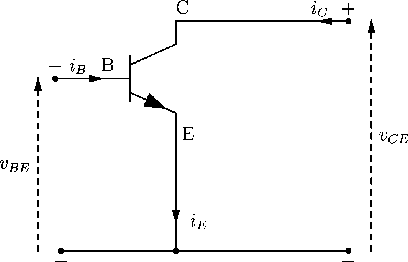 |
A transistor is a device which acts like a controlled valve. The current flow permitted can be controlled.
The bipolar junction transistor (BJT) is a three-terminal electronic valve - the output (collector) terminal current-voltage characteristics are controlled by the current injected into the input port (base). The BJT is a semiconductor device constructed from two pn junctions. There are two types of BJT: pnp and npn. Figures 91 and 92 show the circuit symbols and common current and voltage polarities during normal (active) operation.
The terminals are named: base (B), emitter (E), and collector (C), as shown.
We will be looking mostly at npn transistors; pnp transistors operate similarly except for polarities.
Basic npn transistor relations are
ANU Engineering - ENGN2211